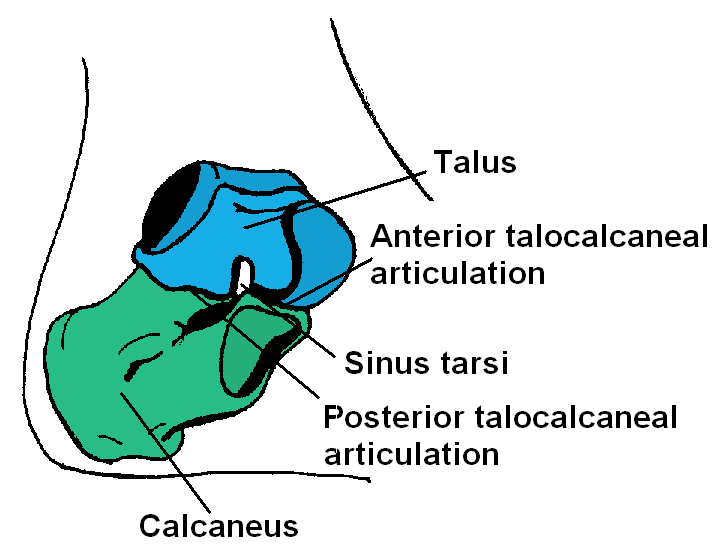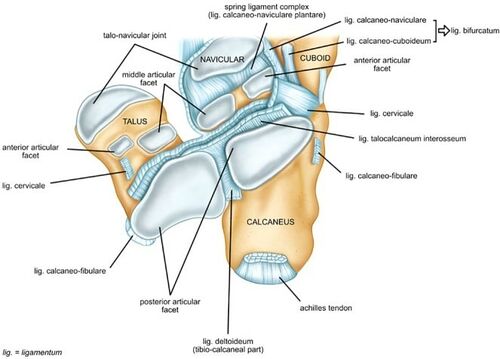Talocalcaneal Joint (Subtalar Joint): Difference between revisions
mNo edit summary |
No edit summary |
||
| Line 1: | Line 1: | ||
{{stub}} | {{stub}} | ||
{{ | {{joint | ||
|image=Subtalar joint anatomy basic.png | |||
|name= | |||
|synonym= | |||
|type= | |||
|bones=Talus and Calcaneus | |||
|ligaments=Multiple, interosseous talocalcaneal ligament is most important | |||
|muscles= | |||
|innervation=Medial plantar, lateral plantar, and deep fibular nerves | |||
|vasculature=Posterior tibial and fibular arteries | |||
|rom=Inversion and eversion | |||
|volume= | |||
|conditions= | |||
}} | |||
The '''talocalcaneal joint''', also called the clinical '''subtalar joint''', is an important and complex joint in the hindfoot that allows articulation of the talus and calcaneus. | The '''talocalcaneal joint''', also called the clinical '''subtalar joint''', is an important and complex joint in the hindfoot that allows articulation of the talus and calcaneus. | ||
=== Articulations === | === Articulations === | ||
The calcaneus forms a triplanar, uniaxial joint with the talus. | [[File:Subtalar joint anatomy.jpg|thumb|500px|The subtalar joint<ref name="nicola"/>]] | ||
The calcaneus forms a triplanar, uniaxial joint with the talus. | |||
*Anteriorly, the talus sits on the anterior and middle facets of the calcaneus, forming the acetabulum pedis with the posterior surface of the navicular bone. | |||
*Posteriorly the concave facet of the talus sits on the convex posterior facet of the calcaneus | |||
The anterior and middle facets are concave; while the posterior facet is convex. The anterior facet sits just lateral to the medial facet. The posterior facet is the largest of the three. It is separated from the other two facets by the interosseous calcaneal ligament. | |||
The anterior talo-calcaneal articulation (anterior and middle facets) are often congruent and are part of a separate synovial cavity (talocalcaneonavicular joint) to the posterior talocalcaneal articulation. The posterior talocalcaneal articulation (posterior facet) only, comprises the anatomical subtalar joint. | |||
The three calcaneal facets vary in their shape between individuals. Variations are common and include combined anterior and middle facets in ovoid form in 42%, bean form in 22%, and complete separation in 36%. | |||
The sustenataculum tali is comprised of the dorsal surface of the middle calcaneal facet. It allows slides of the tibialis posterior, flexor hallucis longus, and flexor digitorum longus tendons.{{#pmid:28828179|nicola}} | |||
=== Ligaments === | === Ligaments === | ||
| Line 22: | Line 39: | ||
* tibiocalcaneal ligament of the deltoid | * tibiocalcaneal ligament of the deltoid | ||
There is | There is support from the tendons of peroneus longus, peroneus brevis, flexor hallucis longus, tibialis posterior, and flexor digitorum longus. | ||
The calcaneus receives additional support through articulation with the navicular bone and by the spring ligament. The spring ligament is important in stabilising the head of the talus. Spring ligament insufficiency can lead to acquired flat foot deformity. | |||
=== Movement === | === Movement === | ||
| Line 33: | Line 52: | ||
Nerves: The plantar aspect of the joint is innervated by the medial or lateral plantar nerve. The dorsal aspect of the joint is supplied by the deep fibular nerve. | Nerves: The plantar aspect of the joint is innervated by the medial or lateral plantar nerve. The dorsal aspect of the joint is supplied by the deep fibular nerve. | ||
== References == | == References == | ||
* https://radiopaedia.org/articles/talocalcaneal-joint | * https://radiopaedia.org/articles/talocalcaneal-joint | ||
* Brockett, Claire L, and Graham J Chapman. “Biomechanics of the ankle.” ''Orthopaedics and trauma'' vol. 30,3 (2016): 232-238. doi:10.1016/j.mporth.2016.04.015 | * Brockett, Claire L, and Graham J Chapman. “Biomechanics of the ankle.” ''Orthopaedics and trauma'' vol. 30,3 (2016): 232-238. doi:10.1016/j.mporth.2016.04.015 | ||
<references/> | |||
[[Category:Foot and Ankle Anatomy]] | [[Category:Foot and Ankle Anatomy]] | ||
Revision as of 13:37, 17 July 2021
{{{{{quality}}}}}

| |
| Talocalcaneal Joint (Subtalar Joint) | |
|---|---|
| Primary Type | |
| Secondary Type | |
| Bones | Talus and Calcaneus"Talus and Calcaneus" is not in the list (Vertebra, Sacrum, Coccyx, Scapula, Clavicle, Humerus, Radius, Ulna, Scaphoid, Lunate, ...) of allowed values for the "Has joint bones" property. |
| Ligaments | Multiple, interosseous talocalcaneal ligament is most important |
| Muscles | |
| Innervation | Medial plantar, lateral plantar, and deep fibular nerves |
| Vasculature | Posterior tibial and fibular arteries |
| ROM | Inversion and eversion |
| Volume | |
| Conditions | |
The talocalcaneal joint, also called the clinical subtalar joint, is an important and complex joint in the hindfoot that allows articulation of the talus and calcaneus.
Articulations

The calcaneus forms a triplanar, uniaxial joint with the talus.
- Anteriorly, the talus sits on the anterior and middle facets of the calcaneus, forming the acetabulum pedis with the posterior surface of the navicular bone.
- Posteriorly the concave facet of the talus sits on the convex posterior facet of the calcaneus
The anterior and middle facets are concave; while the posterior facet is convex. The anterior facet sits just lateral to the medial facet. The posterior facet is the largest of the three. It is separated from the other two facets by the interosseous calcaneal ligament.
The anterior talo-calcaneal articulation (anterior and middle facets) are often congruent and are part of a separate synovial cavity (talocalcaneonavicular joint) to the posterior talocalcaneal articulation. The posterior talocalcaneal articulation (posterior facet) only, comprises the anatomical subtalar joint.
The three calcaneal facets vary in their shape between individuals. Variations are common and include combined anterior and middle facets in ovoid form in 42%, bean form in 22%, and complete separation in 36%.
The sustenataculum tali is comprised of the dorsal surface of the middle calcaneal facet. It allows slides of the tibialis posterior, flexor hallucis longus, and flexor digitorum longus tendons.[1]
Ligaments
There are a number of ligaments. The key one is the interosseous talocalcaneal ligament.
- Interosseous talocalcaneal ligament: This is the key ligament. It is strong, thick ligaments that extends from the articular facets of the inferior talus to the superior surface of the calcaneus.
- Lateral talocalcaneal ligament: relatively weak
- Anterior talocalcaneal ligament: relatively weak
- Calcaneofibular part of the lateral collateral ligament
- tibiocalcaneal ligament of the deltoid
There is support from the tendons of peroneus longus, peroneus brevis, flexor hallucis longus, tibialis posterior, and flexor digitorum longus.
The calcaneus receives additional support through articulation with the navicular bone and by the spring ligament. The spring ligament is important in stabilising the head of the talus. Spring ligament insufficiency can lead to acquired flat foot deformity.
Movement
The geometry of the joint allows inversion and eversion of the ankle, and most of eversion and inversion of the foot occurs here.
Neurovascular Supply
The joint is supplied by two arteries and two nerves.
Arteries: Posterior tibial and fibular arteries
Nerves: The plantar aspect of the joint is innervated by the medial or lateral plantar nerve. The dorsal aspect of the joint is supplied by the deep fibular nerve.
References
- https://radiopaedia.org/articles/talocalcaneal-joint
- Brockett, Claire L, and Graham J Chapman. “Biomechanics of the ankle.” Orthopaedics and trauma vol. 30,3 (2016): 232-238. doi:10.1016/j.mporth.2016.04.015

